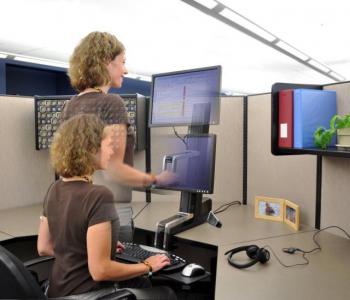As evidence that too much sitting is a risk factor for ill-health
accumulates, employers are introducing sit-stand desks in their office spaces. Now, a
new study suggests this may be a good move, as it finds employees with sit-stand desks stand for 1 hour more a day at work, compared with co-workers who have
sit-only desks.

Workers with sit-stand desks stood on average for 1 hour more a day than co-workers with sit-only desks.
Image credit: University of Iowa Department of Health and Human Physiology
The study of 69 office workers also finds that the sit-stand desk users walked an
additional 6 minutes a day at work and burned an extra 87 calories on average, compared with co-workers with sit-only desks.
The researchers, from the University of Iowa in Iowa City, report their findings
in the American Journal of Preventive Medicine.
Several studies have highlighted the negative effects on health of prolonged
sitting. Experts recently advised that office workers
should stand for at least 2 hours of their typical working day as part of a
cluster of strategies to protect against the negative health effects of sedentary
jobs.
In their paper, the Iowa researchers note how sedentary jobs have increased by
83% in the US since 1960, and 43% of jobs in the country are now largely sedentary:
“Office workers sit more than 80% of the workday, placing them at
increased risk for many sedentary-related pathologies.”
Such a high level of physical inactivity is thought to raise the risk of
developing chronic conditions such as cardiovascular disease, high blood pressure and obesity.
The researchers note that today’s American office workers also burn about 100 calories
less per day than their 1960s counterparts – a reduction that is thought to have
contributed to the obesity epidemic that has emerged over the same period.
Sit-stand desks to encourage more standing, less sitting
Following such revelations, employers have started giving their office workers
sit-stand desks, and research suggests this is having an impact on reducing sitting
time.
A sit-stand desk is a height-adjustable desk designed to make it easy to move the
worker’s posture from sitting to standing and back again. There are many different
designs. The sit-stand desks in this study were of the electric hoist type.
However, the authors note that while most studies focus on the period
following the introduction of the new desks, theirs looks at the period after the
novelty has worn off – an average of 1.8 years after introduction.
First author Lucas Carr, an assistant professor in the Department of Health and
Human Physiology, says looking at this later time frame is likely to be a truer test
of whether workers will continue to use their sit-stand desks over a decade-long
career.
Also, their cross-sectional study – which looks at workers’ activity over a 5-day
working week – is one of the few to also examine links with measures of heart and
metabolic health, he adds.
The Iowa team finds that while sit-stand desks on their own do not appear to
improve markers of heart and metabolic health, they do offer a sustainable way to
get our large and growing sedentary workforce to spend less time sitting and more
time standing. Prof. Carr notes:
“Our findings are important because they support redesigning the
traditionally sedentary office environment as a potentially cost-effective approach
for fighting the obesity epidemic.”
Of the 69 middle-aged, mostly female office workers observed in the study, 31
were users of sit-stand desks and 38 used sit-only desks. Their jobs ranged from
administrative and clerical, through statistical and testing, to accounting,
marketing, research and management.
Increased standing ‘could be part of a larger health plan’
The participants wore monitors known to be accurate at measuring physical
activity in different postures (sitting, standing and walking) around the clock for
5 work days.
Measures of heart and metabolic health were collected in a controlled laboratory
setting. These included heart rate, blood pressure, weight, fat mass, waist size and cardiorespiratory fitness.
The researchers found that while the sit-stand desk users burned more
calories than their seated counterparts, there were no differences in
cardiometabolic health risk factors such as weight, percent body fat, blood
pressure and heart rate.
However, Prof. Carr says perhaps it takes several years for the effect of standing
for an hour or more each day to translate to such differences. Also, their study may
have been too small to spot them.
“The message here is that we need to do more research to determine the true
health benefits of replacing sitting with standing,” he suggests. Also, as far as
losing weight is concerned, it appears that standing alone is not likely to be
enough – but it “could be one piece of an individual’s larger health plan that also
includes healthy eating and physical activity.”
Meanwhile, Medical News Today recently learned that replacing 1 hour of sitting with walking daily can
reduce the risk of premature death by up to 14%. Researchers from the University of
Sydney in Australia came to this conclusion after a study of 200,000 middle-aged and
older participants.
Written by Catharine Paddock PhD
Copyright: Medical News Today
Read more breaking health news on our homepage